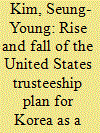| Srl | Item |
| 1 |
ID:
076927


|
|
|
|
|
| Publication |
2007.
|
| Summary/Abstract |
This article shows that in situations of multipolarity Japan has been active and adroit in dealing with the developments on the Korean peninsula, which is a microcosm of the strategic situation in Northeast Asia. It shows such a dynamic by examining two periods of multipolarity in East Asia: the era of the Russo-Japanese War and the détente era of the early 1970s. Japanese diplomacy in the 1970s was carried out under the constraints of its peace constitution and under United States protection. But, even subject to such conditions, Japan actively worked to diplomatically promote its position on the Korean question. Though mainly a historical review, this article provides evidence that supports a realist explanation for Japan's activist foreign policy. This trend also helps to explain the recent activist initiatives in Japanese diplomacy towards Korea in the post-Cold-War era.
|
|
|
|
|
|
|
|
|
|
|
|
|
|
|
|
| 2 |
ID:
121417


|
|
|
|
|
| Publication |
2013.
|
| Summary/Abstract |
During the Second World War, the American State Department prepared a Korean trusteeship plan with a view to mitigate Great Power rivalry over Korea after Japanese defeat. To achieve this goal, the Department recommended that American leaders consult with Russian leaders to manage the joint trusteeship whilst maintaining the administrative unity of Korea. However, amid a sharp rise of threat perception over Soviet expansion and the expectation of the development of an atomic bomb, the Truman Administration delayed diplomatic consultations with the Russians after April 1945. Furthermore, due to a lack of proper co-ordination in Washington's bureaucracy, a valuable opportunity for diplomatic compromise on Korean trusteeship was missed when Harry Hopkins visited Moscow in late May 1945. Although the Potsdam Conference offered the final opportunity for compromise, James Byrnes chose to pursue a unilateralist policy to secure a separate zone of occupation below the 38th parallel with Truman's full support. This article examines American decision-making and diplomacy whilst taking into account its leaders' threat perception as well as their confidence derived from the atomic monopoly.
|
|
|
|
|
|
|
|
|
|
|
|
|
|
|
|
| 3 |
ID:
068855


|
|
|